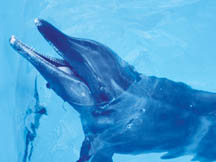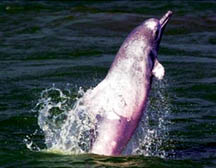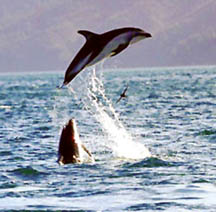|
observer |
|
|
|
|
|
OTHER LINKS |

|

|

|
|
|
|
|
Now, how does this happen, you may wonder. Complex nerve endings around the hole helps the dolphin to sense pressure changes and temperature changes that normally take place when it nears the surface.
Once it reaches the surface, it could release air through its blowhole at speeds of 100 mph. Apart from helping their own kind, these highly intelligent animals help other species in danger, including humans.
Eating habits and reproduction
Dolphins are carnivores and feed mostly on fish, squids and other small sea creatures. They hunt food using their sonar systems and are active during the night. They are predators and chase their prey at high speed using a number of methods of hunting such as herding, stunning, foraging and mudding.
Babies - Dolphin babies or calves are born tail first, with their eyes open. Their senses are very alert and they have enough muscular co-ordination to follow their mother soon after they are born.

Bottlenose dolphin calves are about 90-130 cm when they are born, but grow up to about 4 mtrs as adults.
The calves stay with their mother for up to 3 or 6 years, nursed by them for at least four years. During their stay with their mother, the calves learn everything about feeding techniques, social interaction and group foraging.
Of the many species of dolphins found swimming in the tepid waters of Hawaii, the most common are the Spinner Dolphins, Spotted (Kiko), Bottlenose and Rough-toothed Dolphins. The Hawaiian Spotted Dolphins are shaped and coloured differently to other spotted dolphins.
In general, Spinners are slender with long, thin beaks and distinct stripes, connecting the long pointed flippers to the eyes. They weigh around 45 kg to 75 kg and are 1.3m to 2.1m in length. They too eat squid and fish like other dolphins, but they eat mostly at night.
|
|
Spinners are found in tropical and sub-tropical oceans worldwide. They often mingle with Pilot Whales, Spotted Dolphins and Skipperjack Tuna.
Dusky Dolphins are relatively small and are called the 'acrobats of the sea' because they leap right out of the water.
Usually, these dolphins are found in temperate waters. The Stenos or Rough-toothed Dolphins are thought to be uncommon. They have white lips, sharp teeth, large pectoral fins and tall dorsal fins. There are numerous fine ridges on their teeth.
The Indo-Pacific Humpbacked Dolphin has a crooked dorsal fin which is wide at the base, rising to a triangle pointed tip.
The dorsal fin surmounts a hump which is more prominent in the humpbacks found in the Indian Ocean.
In the Common Dolphins, the flanks are coloured ochre and grey and the dolphins have a distinct stripe around the eye.
The dorsal fins are triangular shaped and prominent. The flippers are pointed, while the bodies are slender and streamlined. They too sometimes leap out of the water like the Dusky Dolphins.
The spotted dolphins have characteristic white-tipped noses. It's a small, toothed whale that has a long, beak-like snout, a sickle-shaped dorsal fin and sharp teeth. The Bottlenose Dolphins have stream-lined bodies and rounded heads with a distinctive beak.
They are the largest among the beaked dolphins. They have a tall, sickle-shaped dorsal fin and broad, slightly pointed flippers. Bottlenose Dolphins are not endangered. They are occasionally killed for their meat by accident or because they often swim with tuna and get trapped in nets. These dolphins are among those used to perform at marine shows. The TV series Flipper portrayed a Bottlenose dolphin.
The Killer Whale or Orca is a very fast swimmer, and an efficient predator that eats fish, squid and other small marine creatures. They even attack huge young blue whales.
It is sometimes called the 'Wolf of the sea.' They have 10-13 pairs of large, interlocking fonical, enamelled teeth on both the upper and lower jaws. The teeth curve inwards and backwards.













